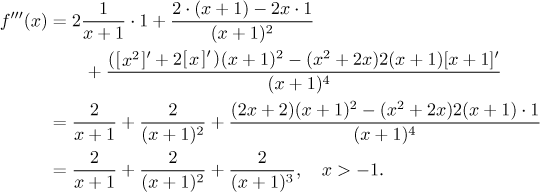Problem: Find the third derivative of
![]()
Solution: We start by finding the first derivative. The function is given by a formula, so we differentiate using rules. The last operation done in the given expression is multiplication (it is a product of two terms), therefore we start with it and apply the product rule.
![]()
We have two derivatives to work out. The first one is an elementary
derivative, we remember the formula for it. The second derivative involves a
composed expression (it is a logarithm of something), so we need to apply the
chain rule with logarithm being the outer function (it is done last when
evaluating, so we differentiate it first). We remember that the derivative of
![]()
The derivative of a linear expression is something we should remember:
[Ax + B]′ = A.
Therefore we get
![]()
Now we take the derivative of this to get the second derivative. The last operation done is the addition (it is a sum of two terms), so we use linearity of derivative.
![]()
The first derivative has product as the last operation, so we use the product rule. In the second derivative we divide as the last operation (the expression is a ratio of two terms), so we use the quotient rule.
![]()
We take it from the left. The first derivative involves a linear expression, we saw the rule above. Then we have the derivative of the composed logarithm that we also worked out above, so we use the result. In the fraction we first have an elementary derivative that we did once before, and then the derivative of a linear expression. We get

To get the third derivative we differentiate the second derivative once more. First we use linearity of derivative, then the quotient rule at two places.

All derivatives are types that we saw before with one exception, the one on
the right. There we see a composition, the outer function
y2 with derivative

We did not forget to specify the domain of this derivative. Note that the
last expression by itself is also defined for
Remark: Some people remember special rules for elementary derivatives that already incorporate the chain rule. For instance, in this problem they would use the rules
[ln(y)]′ = (1/y)⋅[y]′, [y2]′ = 2y⋅[y]′.